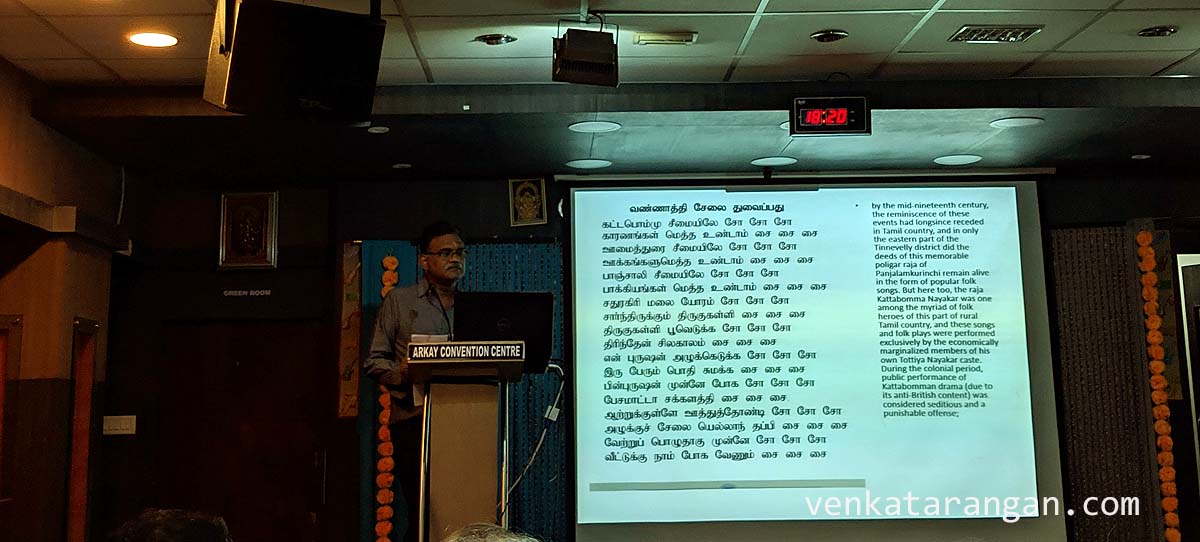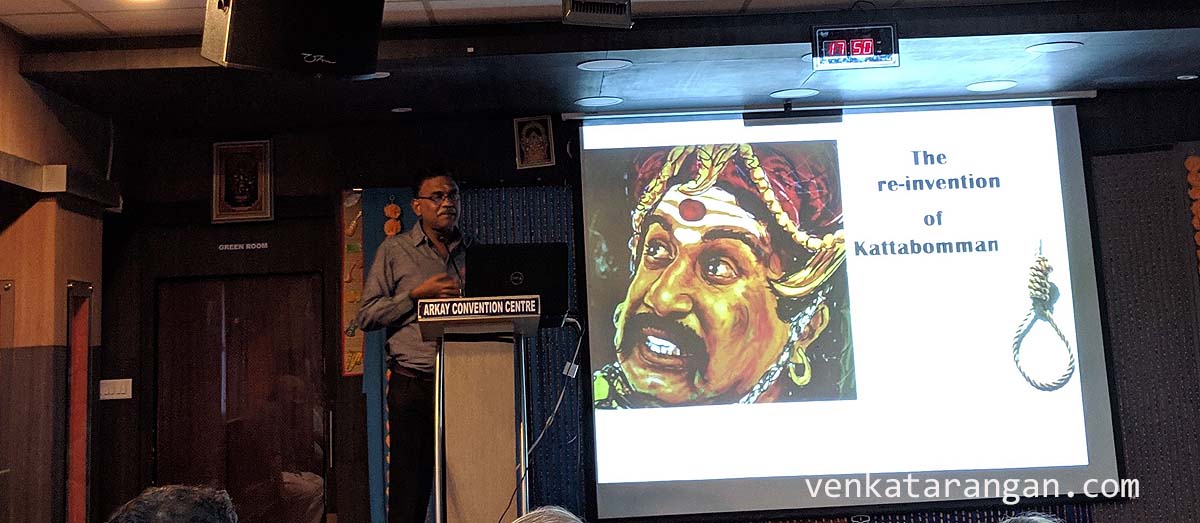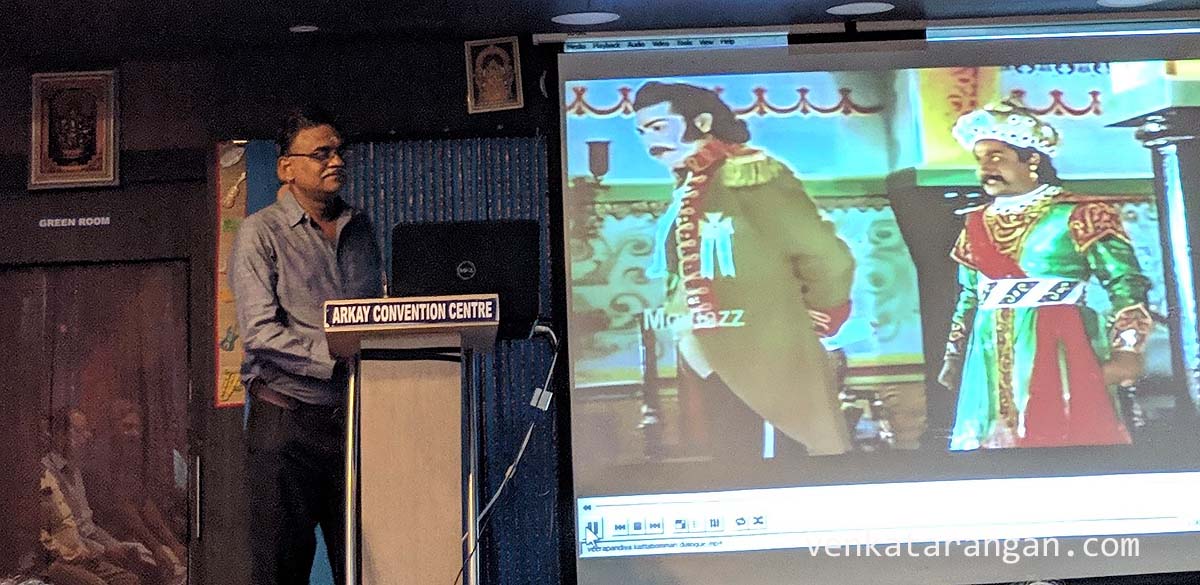A few weeks back on a Saturday (6th April 2019) Mr Venkatesh Ramakrishnan, who is a bilingual novelist, and author of several books including ‘Gods Kings and Slaves’, unraveled the puzzle of how Veerapandiya Kattabomman (வீரபாண்டிய கட்டபொம்மன்) of Nayak dynasty, one of the earliest opponents of the British from Tamil Nadu who was hanged in 1799, suddenly became a household name. It was fascinating to listen to Mr Ramakrishnan whose search taking him to place in the 1940s and 1950s – you can see the recording here.
A few of the points that I noted from his talk (in random order):
- Chennai’s River Kovam has enough history for every mile as River Ganga
- Chhatrapati Shivaji had never been to Mumbai, but he had come very close to Chennai to Gingee Fort
- Puli Thevar (பூலித்தேவன்) is considered to be the earliest from Tamil Nadu to oppose the British
- Madras Regiment is one of the oldest infantry regiment of the British Indian Army, originating in the 1750s, formed in Cuddalore. This battalion was loyal to the British, fought against Tipu Sultan, and there was not even a murmur against the imperialist here in 1857
- Kattabomman assisted his father Jegaveera Kattabomman who was a Polygar (Palaiyakkarar) of Panchalakurichi
- It is not as if Kattabomman had opposed the British from the beginning. He had been paying them the levies due, and in an occasion(s) he had paid 2000 (Rupees? or Varahas?) and fell short by 1000 – that and the suspicion of a trickery planned by the British was the start of Kattabomman’s revolt. Detailed records of these are available from the notes of the serving British officers
- The Maruthu Pandiyars were a bigger kingdom and had more forces
- The rulers of Ettayapuram (எட்டயபுரம்), though in folklore this town has an unfair reputation due to Ettapan, they were actually kind and capable, they were patrons to many poets and artists over the century including the famous Subramanya Bharathy. The rulers spoke Telugu and even their insignia had Telugu letterings
- The British had developed so much hatred towards Kattabomman and wanted to mark his fall as a symbol of warning to anyone else planning to revolt against them, that they demolished, torched the whole fort of Panchalankurichi and poured salt
- Till the early 1940s, Kattabomman was forgotten and relegated to folk stories and spoken only in the local community. It was then the famous writer Kothamangalam Subbu (கொத்தமங்கலம் சுப்பு) writes a book Kattapommu Kathai (கட்டபொம்மு கதை) on him and it was rumoured that Thiru Ma.Po.Si, was offended for an unknown reason in a dinner event hosted by erstwhile rulers of Ettayapuram that he took upon him to popularise their nemesis Kattabomman through a book and other works. Thiru M. P. Sivagnanam’s enthusiasm for popularising the life of the Polygar chieftain Veerapandiya Kattabomman as a resistance fighter was derived initially from a line written by Thiru Subbu in a song from Miss Malini (story for which was written by the legendary Mr R.K.Narayan – the only Tamil film for which he had written the story – the film was accompanied in theatres by Cinema Kadhambam, the first animated film produced in South Indian cinema), which mentions Kattabomman along with Mahatma Gandhi and Subhas Chandra Bose.

Thiru Kothamangalam Subbu (திரு கொத்தமங்கலம் சுப்பு) writes a book Kattapommu Kathai (கட்டபொம்மு கதை)
- Following these, Thiru Sakthi T. K. Krishnasamy writes a story about Kattabomman and it was produced as a film in 1959 by Mr B. R. Panthulu– acted by legendary Sivaji Ganesan – the movie became a super hit and created the image of Kattabomman being the fearless warrior he was in the imagination of Tamilians ever after

Still from a Telugu film on Veerapandiya Kattabomman

Ariyanatha Mudaliyar was the dalavoy of Vishwanatha Nayak (Governor under King Krishnadevaya of Vijayanagar). It was under him the Madurai kingdom was reorganised into the Palayakkarar system He is commemorated in the Madurai 1000 pillar hall as a donor, and in the temple of his home-town Mappedu, in a pose resembling that of Lord Ranganatha.

One of the many Tamil folk songs featuring Kattabomman, that kept his legacy alive for centuries, despite the many efforts of the British to erase even the traces of him from history – the song is given in full below:
கட்டபொம்மு சீமையிலே சோ சோ சோ
காரணங்கள் மெத்த உண்டாம் சை சை சை
ஊமைத் துரை சீமையிலே சோ சோ சோ
ஊக்கங்களு மெத்த உண்டாம் சை சை சை
பாஞ்சாலி சீமையிலே சோ சோ சோ
பாக்கியங்கள் மெத்த உண்டாம் சை சை சை
சதுர கிரி மலை யோரம் சோ சோ சோ
சார்ந்திருக்கும் திருகுகள்ளி சை சை சை
திருகுகள்ளி பூவெடுக்க சோ சோ சோ
திரிந்தேன் சிலகாலம் சை கை சை
என் புருஷன் அழுக்கெடுக்க சோ சோ சோ
இரு பேரும் பொதி சுமக்க சை சை சை
பின்புருஷன் முன்ன்னே போக சோ சோ சோ
பேசமாட்டா சக்களத்தி சை சை சை
ஆற்றுக்குள்ளே ஊத்துத்தோண்டி சோ சோ சோ
அழுக்குச் சேலை யெல்லாந் தப்பி சை சை சை
வேற்றுப் பொழுதாகு முன்னே சோ சோ சோ
வீட்டுக்கு நாம் போக வேணும் சை சை சை
(Source: Tamil Wikipedia Page 1 and Page 2)
YouTube video of Reinvention of Kattabomman – a talk by Venkatesh Ramakrishnan.






Comments